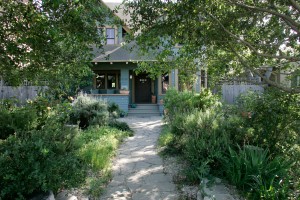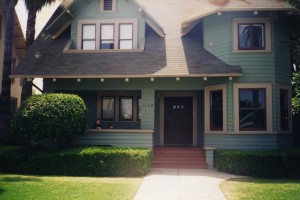Going native
Posted on | December 3, 2009 | 8 Comments

2008: Garden in transition to strongly native with no built-in irrigation and only occasional hose watering. Plants in image: live oaks, irises, lavender, coyote bush, native honeysuckle, ceanothus, poppies and one very hardy tea rose. Paving part of a zero runoff water-capturing design adapted in Los Angeles to City of Santa Monica standards.
Emily Green, publisher of this website and writer of the “Dry Garden” column for the Los Angeles Times, will be speaking on December 8th at the California Native Plant Society on “A Decade of killing plants and learning from the survivors.” Snapshots, left, are examples from the period, from 1998 to 2008, during which Green began chronicling for the Times the transition from conventional to native gardening.
For information, click here.
Tags: California Native Plant Society > chance of rain > Emily Green > Native Gardening
Comments
8 Responses to “Going native”
Leave a Reply





December 3rd, 2009 @ 5:27 pm
I take heart that my garden in Fullerton is in the “interim stage.” Nicely done Emily.
December 3rd, 2009 @ 7:12 pm
I just love your garden and of course your lovely home!
I love the occasional water part!! How do you think I got my water bill down to $10.00 a month!
I’m not DWP’S best customer, but natures advocate!!
Right on Emily!!
December 4th, 2009 @ 10:18 am
What a yummy-looking garden (now) 🙂
December 4th, 2009 @ 1:08 pm
Thank you!
December 5th, 2009 @ 9:56 am
Very pretty, very inviting: the oaks have grown fast!
What do the neighbors think? Have you started a local trend?
December 5th, 2009 @ 10:36 am
Young live oaks do grow fast. I don’t know where that old saw about them being slow growers comes from. They only slow down when they become large, another endearing trait.
My neighbors have been very tolerant of a style that is abhorrent to more than a few of them. The most actively involved has been my next door neighbor, with whom I’ve designed curving paths to integrate my creeping woodland with his lawn instead of a settling for a rude and sharp divide.
Have I started a local trend? I think I’ve probably followed one. Jennifer Charnofsky of WAHA had natives going in her parkway when I arrived in West Adams in 1998. The garden of local designer Renee Gunter post-dates mine, but is stunning and deeply original. She also xeriscaped the garden of the South Seas House at Arlington and 24th Street, an important public statement.
There are also a number of new residents who have come to the garden to find out who laid out my garden’s hardscape (Nick Tan of Urban Organics). To my relief, the new neighbor across the street is not keeping her lawn, but planning to xeriscape.
But the rule where I live is still lawn. The street prides itself on its open, Irish green parkway and the block club moves strongly to enforce it. As I began digging out lawn, I was tolerated, watchfully, in part because I live toward the end of my block and was not breaking up a central part of a proud sweep of front lawns that extends most of the block.
This early 20th Century Magnificent Ambersons look means a lot to the residents. We profoundly differ on it, both in terms of its beauty and environmental impact, but we tolerate each other. I guess we love what we love and we reflect affection when we garden. We in native gardening are in the business of refreshing affections. It will take time and, I think, beauty.
Thanks for your nice comment.
December 5th, 2009 @ 8:46 pm
Thanks Emily for your response.
I like your woodsy front yard, but I live in an HOA-governed neighborhood that would take issue with it. Is it possible to landscape with water-wise native plants but still keep more-or-less within the landscape conventions of a typical American suburb? Say, a mown lawn of Carex or Fescue with foundation shrubs of clipped Rhamnus or Ribes, or would it just not work? Not aesthetically or not horticulturally, or both? What do you think?
December 6th, 2009 @ 10:52 am
What a wonderful set of pictures! I too moved into an old house (1910) that had the traditional lawn & foundation plants, just like your 1998 picture. And we moved in in 1998. My front yard is still mostly lawn, though the lawn has been shrinking. We have a mature deodar and avocado in the front, so I’ve been working around the edges. Bravo on your beautiful transition!